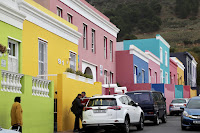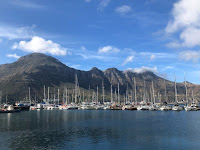Cape Town. The southernmost point on the African continent.
We bid adieu to the remaining members of our tour group at Cape Town International Airport and for a moment, there is an air of excitement. Keith and I together, enjoying each other’s company and ready to explore on our own. Our adventurous spirits, delighted that our trip is not quite done.
We only have a few short days here and we’re determined to make the best of it.
And by “best”, I mean we are upgrading our accommodations to the 5-star Taj Cape Town. After roughing it for a few days (and for this city girl, tent camping in Kruger was most definitely roughing it), we feel totally pampered just walking in the door, which is held open by a doorman in full dress coat. Suffice to say, we would highly recommend this place if you ever venture to Cape Town.
The Victoria and Alfred Waterfront is home to a working harbor, as well as a plethora of shops and eateries.
We find here, an African craft store. And because you can never shop too much (am I right, girls?), we make our way through each room of the four-story market, ooh-ing and aah-ing as we go. I’m still in search of a shield, the likes of which I saw on our first day in Johannesburg and which I haven’t found since. Maybe I’ll find it here.
After searching three floors and still no shield, our stomachs tell us we really should eat something.
Far from home, we settle on something close to home and reminiscent of my heritage: a German brewhaus, complete with German-style craft beer and sausage. Lots and lots of sausage.
The most culturally-diverse city on the continent is home to over 4.5 million people (when you consider the many suburbs). Like most of the places we’ve visited, it too has a storied history, of which Apartheid played a part. Sadly. It is a modern city, trendy, beautifully scenic.
And then there are the shanty towns. Informal Settlements that were established during apartheid and which remain standing and populated today. Those who lost their jobs and were banished from the suburbs and basically became squatters on open, government-owned land. They built homes using whatever materials they could find: scrap tin and wood, mostly. The homes, seemingly built one on top of another. A closer look shows they are built side-by-side, often sharing walls with the adjacent homes.
For many years, there was no electricity. No running water. The government, recognizing they had to provide services, ran central electric lines throughout the settlements and provided communal bathrooms and faucets which allowed the residents to retrieve fresh water.
Our guide tells us there are no rules here, inside the settlements. You can play your stereo as loud as you want and for as many hours into the night as you want. And you can party (and by “party”, we get the distinct feeling he means smoking weed, toking the ganja, partying with Mary Jane). He tells us many who live “in town” maintain a home in these settlements and retreat there on the weekends to relax and do as they please.
It very well may be true, that people retreat to the shanty towns on the weekend. If you happen to be in a gang. We find it hard to believe anyone would consider this a “weekend home”.
 In the neighborhood of Bo-Kaap, the now brightly-colored
houses were originally leased to Dutch slaves. To assert their independence from their
owners, the slaves began to paint their houses, the colors of which identified the
trade of the resident. Need your shoes
repaired? Make your way to the red
house. Need a dress made? The tailor lives in the blue house. As apartheid ended, descendants of the slaves
moved into the homes. Regentrification
of the area now makes it a desirable location for newer Cape Town residents.
In the neighborhood of Bo-Kaap, the now brightly-colored
houses were originally leased to Dutch slaves. To assert their independence from their
owners, the slaves began to paint their houses, the colors of which identified the
trade of the resident. Need your shoes
repaired? Make your way to the red
house. Need a dress made? The tailor lives in the blue house. As apartheid ended, descendants of the slaves
moved into the homes. Regentrification
of the area now makes it a desirable location for newer Cape Town residents.Natural beauty abounds on the Cape.

From rugged mountain tops, to waters the deepest shade of blue, to white sandy beaches deserted save for the few horseback riders because the beach is reserved just for that.
We visited Maiden’s Cove, where we were supposed to have a view of the mountain formation known as The Twelve Apostles. Sadly, this day, the clouds covered the mountains, but the view of the bay was still beautiful.
The drive along the coast took us to Hout Bay, with its many sailboats in the harbor and many seals in the water. And then to Chapman’s Peak. I’m not sure why it’s called Chapman’s Peak, but it provided a gorgeous view of Hout Bay.
And then there is Boulder’s Colony. Its 2200 tuxedo-clad residents freely wandering the beaches. And in the early-morning hours, parading along the street as the shop owners prepare for the hundreds of daily visitors who just want to get close to all the cuteness.
I have long-loved penguins, their waddle creating in me, spontaneous giggles, and visiting Boulder’s Colony made my heart so happy.
 |
| The lighthouse at top, our destination |
Keith loves end-of-the-world type movies. In the movie, “2012”, the natural disasters which have virtually destroyed planet earth, turning it on its axis, leave the survivors to find a new home. They set course for The Cape of Good Hope. This was one of his bucket-list items.
I have to say, there really is not much here. Except for a sign, identifying the spot. The beaches are rocky, the surf, rough, the mountains and landscape left un-touched.
Still, it was just something we had to do.
Our second night in Cape Town again found us at the Waterfront. We dined on the freshest of seafood and made our way to the 4th and final floor of the African Craft Market.
At the top of the stairs, we encounter a couple of the ladies from our tour group. Happy to see familiar faces, we talked about our respective days and again bid them adieu.
Our final day on the African Continent and we are hopeful we’ll make it to the top of Cape Town’s iconic Table Mountain. The day before, we are told, the mountain was shrouded in cloud-cover until late afternoon. There’s really not much sense in going up then.
I feverishly begin praying for a clear morning as we are due to leave for the airport around 1:00 p.m.
We wake up to the sun shining through our curtains and know that are chances have greatly improved.
The hotel’s shuttle service takes us to Table Mountain. Aptly named because indeed, it looks like a table. With Devil’s Peak and Lion’s Head peak book-ending the flat portion.
Upon arrival, who do we spot in the queue, but our tour group! They had attempted to go up yesterday but were unsuccessful. Today, they are all bundled up and ready to go.
Bundled up? You mean it’s going to be cold up at the top?
We opt for the funicular ride to the top, rather than the 2.5-hour hike. We just don’t have that much time (not to mention, we are not really physically prepared for it). Much to our delight, the cable car rotates as you head upward (and downward), providing a 360º view of the mountain.
At the top, paved pathways allow you to traverse the length of the mountaintops and take in all the views.
 But there’s one thing.
It’s windy. And … It. Is. Freezing. Okay – that’s two things.
But there’s one thing.
It’s windy. And … It. Is. Freezing. Okay – that’s two things. We do our best to take in as much as we can as quickly as we can. Because, you know, we’re cold.
Happy that we’ve seen Cape Town in its entirety from this vantage point, we make our way downwards.
 As we await our transportation back to the hotel, the clouds roll over
the top of the mountain. Completely
covering it and reducing visibility to about zero.
As we await our transportation back to the hotel, the clouds roll over
the top of the mountain. Completely
covering it and reducing visibility to about zero.Satisfied that we have checked all of the boxes on our African Adventure, we are headed home.
Without the shield I searched three countries for. But with memories to last us a lifetime.
We are well and truly grateful that we have had this incredibly amazing adventure.
And I thank you for going along for the ride.










No comments:
Post a Comment
We stop growing when we stop learning. If you have some useful feedback for me, please share! I'm always looking for ways to improve! Of course, if you like what you've just read, I'd love to hear that too!